Unit One Study Guide(学习指南)
浙江大学《新编大学英语综合教程(2)》(第3版)学习指南【词汇短语+课文精解+全文翻译+练习答案】
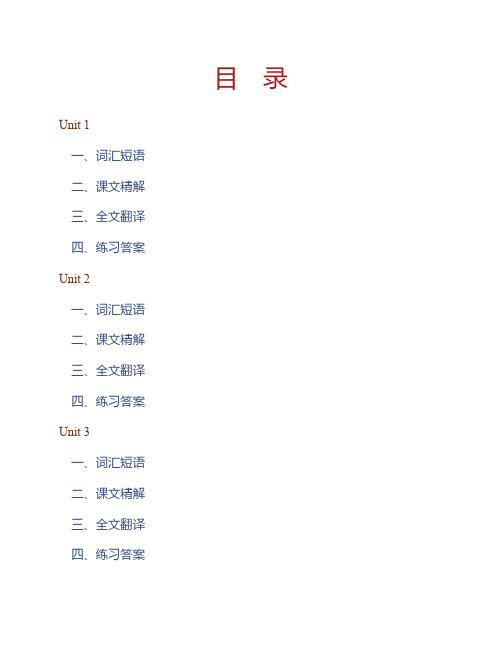
目 录Unit 1一、词汇短语二、课文精解三、全文翻译四、练习答案Unit 2一、词汇短语二、课文精解三、全文翻译四、练习答案Unit 3一、词汇短语二、课文精解三、全文翻译四、练习答案Unit 4一、词汇短语二、课文精解三、全文翻译四、练习答案Unit 5一、词汇短语二、课文精解三、全文翻译四、练习答案Unit 6一、词汇短语二、课文精解三、全文翻译四、练习答案Unit 7一、词汇短语二、课文精解三、全文翻译四、练习答案Unit 8一、词汇短语二、课文精解三、全文翻译四、练习答案Unit 9一、词汇短语二、课文精解三、全文翻译四、练习答案Unit 10一、词汇短语二、课文精解三、全文翻译四、练习答案Unit 1一、词汇短语Part 1. Preparationby its very nature就其本质而言unconditional [5QnkEn5diFEnEl] adj.无条件的,无限制的,绝对的【例句】The victorious army demanded unconditional surrender. 胜方要求敌人无条件投降。
【搭配】unconditional surrender 无条件投降live up to不辜负;做到;实践【例句】In some ways, we failed to live up to one another’s expectations. 在某些方面,我们互相的期望都落了空。
do one’s duty尽职责Part 2. Reading-Centered ActivitiesIn-Class Readingseverely [si5viEli] adv.严格地,激烈地【例句】Those responsible for this crime will be severely punished. 犯下这宗罪行的人将受到严厉惩罚。
severe [si5viE] adj.严厉的,严格的;剧烈的;严重的,严峻的【例句】He’s suffering from severe mental disorder. 他患有严重的精神病。
李观仪《新编英语教程(1)》第3版学习指南【词汇短语+课文精解+全文翻译+练习答案】(Unit 1)
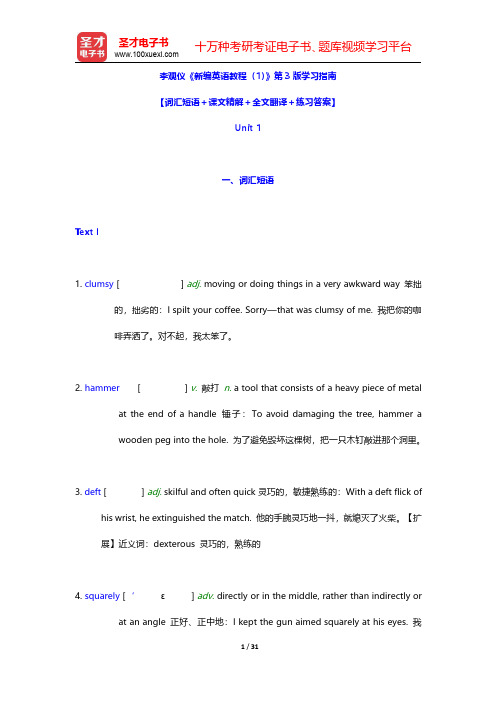
李观仪《新编英语教程(1)》第3版学习指南【词汇短语+课文精解+全文翻译+练习答案】Unit1一、词汇短语Text I1.clumsy[]adj.moving or doing things in a very awkward way笨拙的,拙劣的:I spilt your coffee.Sorry—that was clumsy of me.我把你的咖啡弄洒了。
对不起,我太笨了。
2.hammer[]v.敲打n.a tool that consists of a heavy piece of metalat the end of a handle锤子:To avoid damaging the tree,hammer awooden peg into the hole.为了避免毁坏这棵树,把一只木钉敲进那个洞里。
3.deft[]adj.skilful and often quick灵巧的,敏捷熟练的:With a deft flick ofhis wrist,he extinguished the match.他的手腕灵巧地一抖,就熄灭了火柴。
【扩展】近义词:dexterous灵巧的,熟练的4.squarely[‘ɛ]adv.directly or in the middle,rather than indirectly orat an angle正好、正中地:I kept the gun aimed squarely at his eyes.我一直把枪直直瞄准他的眼睛。
5.apt[]adj.exactly suitable适当的,恰当的:The words of this report are as apttoday as in1929.这份报告的措辞在当今如在1929年一样恰当。
6.scrupulous[]adj.correct even in the smallest detail;exact严格认真的,审慎的:You’re being very scrupulous,but to whatend?你表现得很认真,但目的是什么呢?7.subtle[]adj.not very noticeable or obvious细致的,微妙的,不易察觉的:The truth is subtly different.事实略有不同。
九年级英语电子版-英语9年级上册学习指南

九年级英语电子版-英语9年级上册学习指南一. 内容概述英语9年级上册主要涵盖了以下几个方面的内容:1. Unit 1:词汇与语法的讲解,如介词的用法、情态动词的使用等。
2. Unit 2:听说训练及日常交流,包括询问与回答关于个人喜好和兴趣的问题。
3. Unit 3:读写技巧的训练,包括阅读短文并回答问题,以及写作简短的文章。
4. Unit 4:口语训练,研究表达个人观点和提供建议的方法。
5. Unit 5:听力训练和听力理解,研究听力材料并回答相关问题。
6. Unit 6:阅读技巧的提高,包括阅读理解的训练和提取关键信息。
7. Unit 7:写作能力的提升,研究如何写作不同类型的文章。
二. 研究方法与技巧为了更好地掌握九年级英语上册的内容,以下是一些研究方法与技巧的建议:1. 注重课堂听力训练:认真听讲老师的授课内容,在课堂上积极参与听力训练,提高自己的听力水平。
2. 多阅读英语文章:阅读不同类型的英语文章,提高自己的阅读理解能力。
3. 练写作技巧:多写作不同类型的文章,如记叙文、说明文等,提高自己的写作能力。
4. 制定研究计划:合理安排研究时间,并制定研究计划,按照计划进行研究,有针对性地复重点内容。
5. 制作研究笔记:在研究过程中,及时记录重要知识点和难点,并整理成笔记,方便复和回顾。
6. 利用研究资源:充分利用教材、参考书、研究网站等研究资源,扩展自己的知识面。
三. 研究辅助工具除了以上研究方法与技巧外,以下是一些可以辅助研究的工具和资源:1. 九年级英语教材:认真阅读教材中的课文和练题,完成课后题巩固所学知识。
2. 单词记忆软件:使用手机或电脑上的单词记忆软件,帮助记忆英语单词和词组。
4. 研究社区与论坛:加入英语研究社区或论坛,与其他研究者交流研究心得和问题。
5. 在线课程与视频:观看相关的在线课程和教学视频,加深对知识点的理解。
通过合理的研究方法和辅助工具的使用,相信你能够更好地研究九年级英语上册的内容,取得优异的成绩。
李观仪《新编英语教程(5)》(第3版)学习指南【词汇短语+课文精解+全文翻译+练习答案】

李观仪《新编英语教程(5)》(第3版)学习指南【词汇短语+课文精解+全文翻译+练习答案】目录Unit 1 一、词汇短语 二、参考译文 三、课文注释 四、练习答案Unit 2 一、词汇短语 二、参考译文 三、课文注释 四、练习答案Unit 3 一、词汇短语 二、参考译文 三、课文注释 四、练习答案Unit 4 一、词汇短语 二、参考译文 三、课文注释 四、练习答案Unit 5 一、词汇短语 二、参考译文 三、课文注释 四、练习答案Unit 6 一、词汇短语 二、参考译文 三、课文注释 四、练习答案Unit 7 一、词汇短语 二、参考译文 三、课文注释 四、练习答案Unit 8 一、词汇短语 二、参考译文 三、课文注释 四、练习答案Unit 9 一、词汇短语 二、参考译文 三、课文注释 四、练习答案Unit 10 一、词汇短语 二、参考译文 三、课文注释 四、练习答案Unit 11 一、词汇短语 二、参考译文 三、课文注释 四、练习答案Unit 12 一、词汇短语 二、参考译文 三、课文注释 四、练习答案弘博学习网————各类考试资料全收录内容简介《新编英语教程(第3版)学习指南》按照原教材的课次进行编写,每单元涉及单元语法、词汇短语、参考译文、课文精解以及练习答案等内容,旨在帮助学生更好、更高效地学习和掌握教材中的重点及难点知识,具有很强的针对性和实用性。
在编写过程中,该书力求突出重点,答疑难点,语言言简意赅,讲解深入浅出,希望它能得到广大英语专业学生和英语自学者的喜爱和认可。
弘博学习网————各类考试资料全收录Unit 1一、词汇短语Text I1clumsy [5klQmzi] adj. moving or doing things in a very awkward way 笨拙的,拙劣的:I spilt your coffee. Sorry—that was clumsy of me.我把你的咖啡弄洒了。
第三版新视野大学英语1-unit1学习指南

第三版新视野大学英语1-unit1学习指南本研究指南旨在帮助学生有效地研究第三版新视野大学英语1中的第一单元内容。
以下是一些研究建议和策略,以帮助你充分理解和掌握本单元的知识。
1. 阅读教材认真阅读教材中的每一篇文章和相关练题。
将重点内容标记出来,理解文章的主旨和主要细节。
在阅读过程中,注意词汇和句子的用法,并尝试归纳总结每篇文章的要点。
2. 研究词汇词汇是语言研究的基础,要用心研究本单元中的生词和短语。
可以通过制作词汇卡片、使用词汇记忆软件或与同学互相测试等方式来巩固词汇记忆。
3. 完成练题教材中的练题是巩固研究成果的重要方式。
认真完成每个练题,确保理解题目要求并能正确应用所学知识。
如有不理解的地方,可以寻求同学或老师的帮助。
4. 参与课堂讨论积极参与课堂讨论可以加深对研究内容的理解。
在课堂上,发表自己的观点、提出问题,并与同学互动交流。
这不仅可以加深自己的理解,还可以从他人的观点中获得新的启发。
5. 制定研究计划制定一个合理的研究计划,安排每天的研究时间。
将研究分成小块,每块专注于一项任务或目标。
遵守研究计划,并保持持续的研究动力。
6. 多种方式研究除了课本研究,还可以通过听英语广播、看英语电影和听英语歌曲等方式来提升英语听力和口语能力。
多种方式的研究可以使你的语言技能得到全面提高。
记住,学习是一个持续的过程,需要坚持和努力。
通过以上的学习建议和策略,相信你能够在第一单元中取得良好的学习效果。
祝你学习顺利!。
秦秀白《新世纪大学英语综合教程(1)》学习指南-Unit 1(圣才出品)
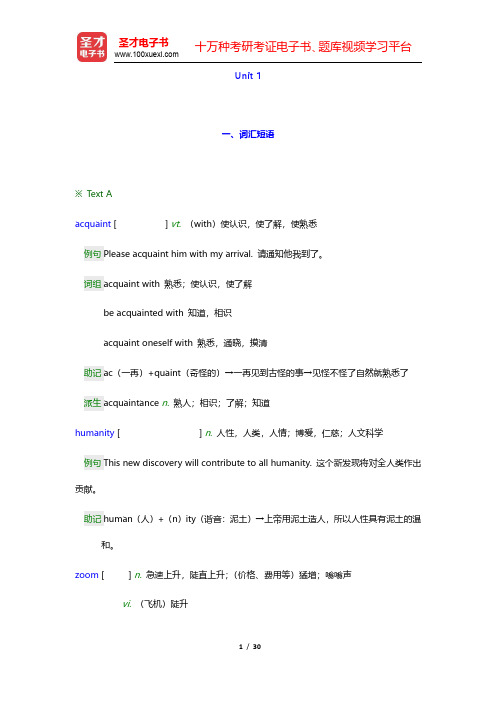
Unit 1一、词汇短语※Text Aacquaint [] vt. (with)使认识,使了解,使熟悉例句Please acquaint him with my arrival. 请通知他我到了。
词组acquaint with 熟悉;使认识,使了解be acquainted with 知道,相识acquaint oneself with 熟悉,通晓,摸清助记ac(一再)+quaint(奇怪的)→一再见到古怪的事→见怪不怪了自然就熟悉了派生acquaintance n.熟人;相识;了解;知道humanity [] n. 人性,人类,人情;博爱,仁慈;人文科学例句This new discovery will contribute to all humanity. 这个新发现将对全人类作出贡献。
助记human(人)+(n)ity(谐音:泥土)→上帝用泥土造人,所以人性具有泥土的温和。
zoom [] n. 急速上升,陡直上升;(价格、费用等)猛增;嗡嗡声vi. (飞机)陡升例句A red signal light zoomed to the sky. 一枚红色信号腾空而起。
词组zoom in放大reference [] n. 提及;参考(书目);证明书(人);介绍信;参考书目v. 引用例句My careful writing results from many references to a dictionary. 我文思缜密是因为我经常查字典。
词组by reference to参照with reference to关于,就…而论in reference to 关于expert [] n. 专家,能手adj. 熟练的,内行的,有经验的;专门的vt. 当专家;在…中当行家例句All the young men are expert drivers. 所有这些年轻人都是驾驶能手。
词组expert in/at 熟于;在…方面是行家助记excerpt(n.& vt.摘录)只有专家才能干的事。
国家开放大学学习指南管理英语一形考任务
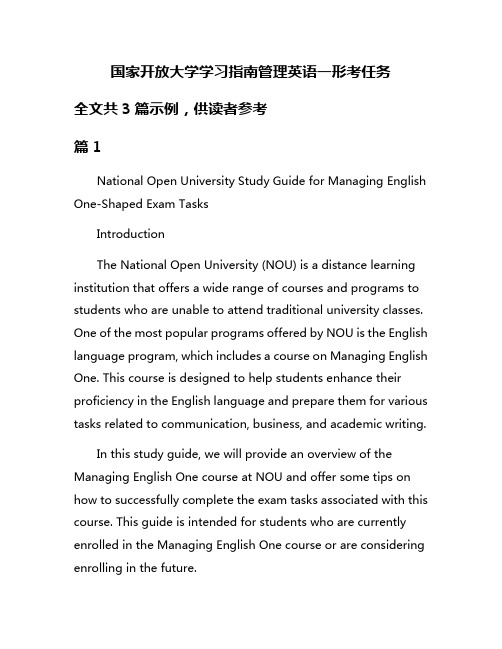
国家开放大学学习指南管理英语一形考任务全文共3篇示例,供读者参考篇1National Open University Study Guide for Managing English One-Shaped Exam TasksIntroductionThe National Open University (NOU) is a distance learning institution that offers a wide range of courses and programs to students who are unable to attend traditional university classes. One of the most popular programs offered by NOU is the English language program, which includes a course on Managing English One. This course is designed to help students enhance their proficiency in the English language and prepare them for various tasks related to communication, business, and academic writing.In this study guide, we will provide an overview of the Managing English One course at NOU and offer some tips on how to successfully complete the exam tasks associated with this course. This guide is intended for students who are currently enrolled in the Managing English One course or are considering enrolling in the future.Course OverviewThe Managing English One course at NOU is a comprehensive program that covers a wide range of topics related to the English language. Some of the key areas covered in the course include:- Academic writing: This section of the course focuses on developing students' skills in writing essays, reports, research papers, and other academic papers. Students will learn how to structure their writing, cite sources properly, and follow academic conventions.- Business communication: In this section, students will learn how to communicate effectively in a business setting, including writing professional emails, reports, and presentations. They will also learn how to conduct meetings, negotiate with clients, and manage conflicts.- Public speaking: This section of the course focuses on helping students improve their public speaking skills, including how to prepare and deliver speeches, engage with audiences, and handle questions and feedback.Exam TasksThe exam tasks for the Managing English One course at NOU are designed to test students' proficiency in the English language and their ability to apply the skills they have learned in the course. Some of the common exam tasks for this course include:- Writing essays: Students may be asked to write an essay on a specific topic related to academic writing or business communication. They will be evaluated on their ability to present a clear argument, provide evidence to support their claims, and follow proper formatting and citation guidelines.- Business report: Students may be required to write a business report based on a case study or real-life scenario. They will need to analyze the information provided, identify key issues, and make recommendations for action.- Public speaking presentation: Students may be asked to prepare a presentation on a specific topic and deliver it to their classmates or instructors. They will be evaluated on their ability to organize their ideas, engage with the audience, and deliver their message effectively.Tips for SuccessTo succeed in the Managing English One course at NOU and excel in the exam tasks, students should keep the following tips in mind:1. Practice writing regularly: Writing is a key component of the course, so students should practice writing essays, reports, and other assignments on a regular basis to improve their skills.2. Seek feedback: Students should seek feedback from their instructors or classmates on their writing and speaking assignments to identify areas for improvement and make necessary adjustments.3. Use resources: Students should make use of the resources available to them, such as online tutorials, sample essays, and writing guides, to enhance their understanding of the course material.4. Manage time effectively: Time management is crucial for completing the exam tasks on time, so students should plan their study schedule accordingly and allocate enough time for each task.ConclusionThe Managing English One course at NOU is a valuable program that can help students enhance their proficiency in theEnglish language and prepare them for various tasks related to communication, business, and academic writing. By following the tips provided in this study guide and putting in the necessary effort and dedication, students can successfully complete the exam tasks associated with this course and achieve their academic goals.篇2National Open University Study Guide Management English One Formative Assessment TaskIntroduction:Welcome to the National Open University Study Guide for Management English One Formative Assessment Task. This guide is designed to help students understand the requirements and expectations for this assessment, as well as provide tips and resources to support their learning.Task Overview:The Management English One Formative Assessment Task is designed to assess students' ability to apply key management concepts to real-world scenarios. The task consists of three components: a written report, a presentation, and a reflective journal.Written Report:In the written report, students will be required to analyze a case study provided by the instructor. The case study will present a specific management challenge or issue, and students will need to apply relevant management theories and concepts to provide a solution or recommendation. The report should bewell-structured, clearly articulated, and supported by evidence from academic sources.Presentation:Students will also be required to deliver a presentation based on their written report. The presentation should summarize the main findings and recommendations from the report, and should be delivered in a clear and engaging manner. Students should use visual aids, such as PowerPoint slides, to support their presentation.Reflective Journal:Finally, students will be asked to keep a reflective journal throughout the assessment process. In the journal, students should reflect on their learning and development, as well as document any challenges they faced and how they overcamethem. The reflective journal is an opportunity for students to demonstrate self-awareness and critical thinking skills.Tips for Success:To succeed in the Management English One Formative Assessment Task, students should:- Start early and manage their time effectively- Discuss the case study with classmates and instructors to gain different perspectives- Use a variety of academic sources to support their analysis and recommendations- Practice their presentation skills and seek feedback from peers- Reflect on their progress and learning throughout the assessment processConclusion:We hope this study guide has provided you with a clear understanding of the requirements and expectations for the Management English One Formative Assessment Task. Remember to use the resources available to you, and don't hesitate to reach out to your instructors for support. Good luck!篇3Study Guide for the National Open University English I Final ExamIntroduction:Welcome to the study guide for the National Open University English I final exam. This guide is designed to help you prepare for the exam by providing tips and strategies for success. Throughout this guide, you will find information on the exam format, study techniques, and sample questions to help you practice.Exam Format:The National Open University English I final exam consists of three parts: reading comprehension, writing, and grammar. The reading comprehension section tests your ability to understand and analyze written texts. The writing section requires you to compose a response to a given prompt. The grammar section assesses your knowledge of English grammar rules.Study Techniques:To prepare for the exam, it is important to develop a study plan and stick to it. Schedule regular study sessions and setspecific goals for each session. Review your notes, textbooks, and any other materials provided by your instructor. Practice reading English texts and writing responses to prompts to improve your skills in these areas. Additionally, consider forming a study group with classmates to discuss the material and quiz each other on key concepts.Sample Questions:1. Reading Comprehension:Read the following passage and answer the questions that follow:"Climate change is a pressing issue that requires immediate action. Rising global temperatures are causing ice caps to melt, sea levels to rise, and extreme weather events to become more frequent. It is essential that governments and individuals take steps to reduce their carbon footprint and mitigate the effects of climate change."a) What is the main idea of the passage?b) What are some of the effects of climate change mentioned in the passage?2. Writing:Write a response to the following prompt:"Should governments implement stricter regulations to reduce air pollution? Why or why not? Support your argument with examples and evidence."3. Grammar:Identify and correct the errors in the following sentence:"Despite of the rain, the outdoor concert was a huge success."Conclusion:By following the tips and strategies outlined in this study guide, you can be well-prepared to excel on the National Open University English I final exam. Remember to study consistently, practice actively, and seek help from instructors or classmates if needed. Good luck with your studies!。
李荫华《全新版大学英语综合教程(3)》(第2版)学习指南【词汇短语+课文精解+全文翻译+练习答案】

李荫华《全新版大学英语综合教程(3)》(第2版)学习指南【词汇短语+课文精解+全文翻译+练习答案】目录Unit 1 一、词汇短语 二、课文精解 三、全文翻译 四、练习答案Unit 2 一、词汇短语 二、课文精解 三、全文翻译 四、练习答案Unit 3 一、词汇短语 二、课文精解 三、全文翻译 四、练习答案Unit 4 一、词汇短语 二、课文精解 三、全文翻译 四、练习答案Unit 5 一、词汇短语 二、课文精解 三、全文翻译 四、练习答案Unit 6 一、词汇短语 二、课文精解 三、全文翻译 四、练习答案Unit 7 一、词汇短语 二、课文精解 三、全文翻译 四、练习答案Unit 8 一、词汇短语 二、课文精解 三、全文翻译 四、练习答案弘博学习网————各类考试资料全收录内容简介本书是《全新版大学英语综合教程(3)》(第2版)的配套辅导用书,按照原教材的课次进行编写,每单元涉及词汇短语、课文精解、全文翻译以及练习答案内容。
词汇短语中精选每单元的重、难点词汇,每个词后除了释义,还给出了相应的例句,及一些常用的搭配、词组、助记方法等。
课文精解从文中选出重点句子及难以理解的句子加以讲解,其中包括对句子结构分析、相关知识点讲解和延伸。
全文翻译是在参阅了大量与教材相关用书的基础上总结编写而成的。
练习答案提供每单元习题的参考答案。
本书旨在帮助学生更好、更高效地学习和掌握教程中的重点及难点知识,具有很强的针对性和实用性。
在编写过程中,该书力求突出重点,答疑难点,语言言简意赅,讲解深入浅出,希望它能得到广大英语学习者的喜爱和认可。
弘博学习网————各类考试资料全收录Unit 1一、词汇短语Text Aget by通过;过得去;过活;获得认可【例句】No one is able to get by without oxygen. 没有氧气人不能维持生命。
frustration [frQs5treiFEn] n. 挫败;挫折;受挫【例句】He ground his teeth (together) in frustration. 他因失败而把牙咬得咯咯响。
guide的用法和搭配
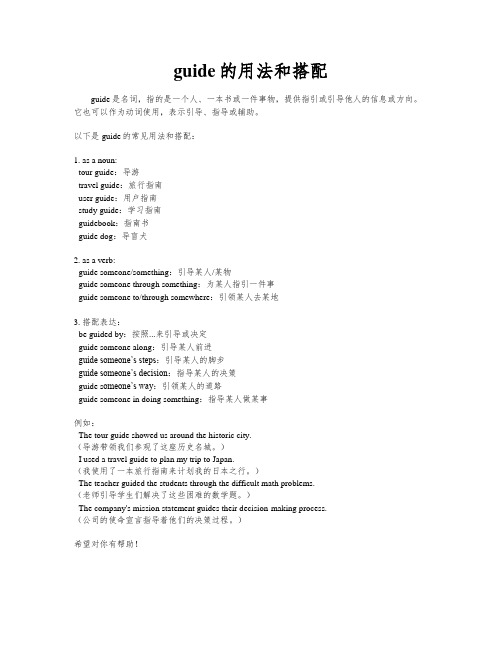
guide的用法和搭配guide是名词,指的是一个人、一本书或一件事物,提供指引或引导他人的信息或方向。
它也可以作为动词使用,表示引导、指导或辅助。
以下是guide的常见用法和搭配:1. as a noun:- tour guide:导游- travel guide:旅行指南- user guide:用户指南- study guide:学习指南- guidebook:指南书- guide dog:导盲犬2. as a verb:- guide someone/something:引导某人/某物- guide someone through something:为某人指引一件事- guide someone to/through somewhere:引领某人去某地3. 搭配表达:- be guided by:按照...来引导或决定- guide someone along:引导某人前进- guide someone’s steps:引导某人的脚步- guide someone’s decision:指导某人的决策- guide s omeone’s way:引领某人的道路- guide someone in doing something:指导某人做某事例如:- The tour guide showed us around the historic city.(导游带领我们参观了这座历史名城。
)- I used a travel guide to plan my trip to Japan.(我使用了一本旅行指南来计划我的日本之行。
)- The teacher guided the students through the difficult math problems.(老师引导学生们解决了这些困难的数学题。
)- The company's mission statement guides their decision-making process.(公司的使命宣言指导着他们的决策过程。
Of Mice and Men 学习指南说明书
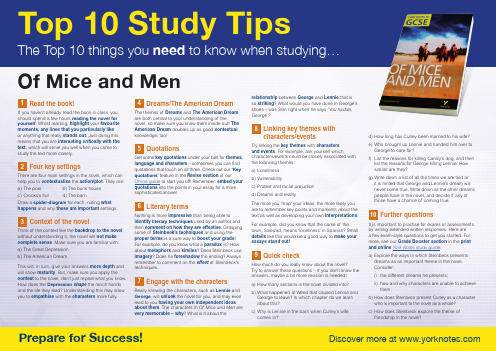
The Top 10 things you need to know when studying…Of Mice and MenPrepare for Success!Discover more at 1 Read the book!If you haven’t already read the book in class, you should spend a few hours reading the novel for yourself . Whilst reading, highlight your favourite moments, any lines that you particularly like or anything that really stands out . Just doing this means that you are interacting critically with the text , which will serve you well when you come to study the text more closely .2 Four key settingsThere are four main settings in the novel, which can help you to contextualise the action/plot . They are:a) The poolb) The bunk house c) Crooks’s hutd) The barnDraw a spider-diagram for each, noting what happens and why these are important settings.3 Context of the novelThink of the context like the backdrop to the novel : without understanding it, the novel will not make complete sense . Make sure you are familiar with:a) The Great Depression b) The American DreamThis will, in turn, give your answers more depth and will show maturity . But, make sure you apply the context to the novel, don’t just repeat what you know. How does the Depression shape the ranch hands and the life they lead? Understanding this may allow you to empathise with the characters more fully .4 Dreams/The American DreamThe themes of Dreams and The American Dream are both central to your understanding of thenovel, so make sure you know them inside out! The American Dream doubles up as good contextual knowledge, too!5 QuotationsGet some key quotations under your belt for themes, language and characters – sometimes you can find quotations that touch on all three. Check out our ‘Key quotations’ feature in the Revise section of ourOnline guide to start you off! Remember: embed your quotations into the points in your essay for a more sophisticated answer .6 Literary termsNothing is more impressive than being able toidentify literary techniques used by an author and then comment on how they are effective . Grasping some of Steinbeck’s techniques and using the proper terms is a sure way to boost your grade ! For example, do you know what a paradox is? How about metaphors and similes ? Does Steinbeck use imagery ? Does he foreshadow the ending? Always remember to comment on the effect of Steinbeck’s techniques.7 Engage with the charactersReally knowing the characters, such as Lennie and George , will unlock the novel for you, and may even lead to you having your own independent ideas about them . The characters in Of Mice and Men are very memorable – why ? What is it about therelationship between George and Lennie that is so striking ? What would you have done in George’s shoes – was Slim right when he says ‘You hadda, George’?8 Linking key themes with characters/eventsTry linking the key themes with characters and events . For example, ask yourself whichcharacters/events could be closely associated with the following themes:a) Loneliness b) Vulnerabilityc) Protest and racial prejudice d) Dreams and realityThe more you ’map‘ your ideas, the more likely you are to remember key points and moments about the text as well as developing your own interpretations . For example, did you know that the name of thetown, Soledad , means ‘loneliness’ in Spanish? Small details like this would be a good way to make your essays stand out!9 Quick checkHow much do you really know about the novel?Try to answer these questions – if you don’t know the answers, maybe a bit more revision is needed!a) How many sections is the novel divided into?b) What happened at Weed that caused Lennie and George to leave? In which chapter do we learn about this?c) Why is Lennie in the barn when Curley’s wife comes in?d) How long has Curley been married to his wife?e) Who brought up Lennie and handed him over to George to care for?f) List the reasons for killing Candy’s dog, and then list the reasons for George killing Lennie. How similar are they?g) Write down a list of all the times we are told or it is hinted that George and Lennie’s dream will never come true. Write down all the other dreams people have in the novel, and decide if any of those have a chance of coming true.10 Further questionsIt is important to practise for exams or assessments by writing extended written responses. Here are a few exam-style questions to get you started. For more, see our Grade Booster section in the print and online York Notes study guide :a) Explore the ways in which Steinbeck presents dreams as an important theme in the novel. Consider:i) the different dreams he presents;ii) how and why characters are unable to achieve them.b) How does Steinbeck present Curley as a character who is important to the novel as a whole?c) How does Steinbeck explore the theme of friendship in the novel?Top 10 Study Tips。
新编英语教程1学习指南pdf

新编英语教程1学习指南pdf The New English Course 1 Study Guide is designed to assist students in mastering the English language. With a focus on practical and effective learning methods, this guide aims to help students improve their speaking, listening, reading, and writing skills.The study guide is divided into several sections, each focusing on a different aspect of the English language. The first section covers basic grammar and vocabulary, providing students with a solid foundation for further learning. This section also includes exercises andactivities to reinforce the concepts covered.The second section of the study guide focuses on listening and speaking skills. Students will have the opportunity to practice their listening comprehension and speaking abilities through a variety of exercises and activities. This section also includes tips and strategies for improving pronunciation and fluency.The third section of the study guide is dedicated to reading comprehension. Students will have the chance toimprove their reading skills through a series of texts and comprehension questions. This section also includes vocabulary-building exercises to help students expand their word knowledge.The final section of the study guide focuses on writing skills. Students will learn how to structure and organize their writing, as well as how to effectively express their ideas in English. This section also includes writingprompts and exercises to help students practice theirskills.Overall, this study guide provides a comprehensive and structured approach to learning English. By following the guidance and completing the exercises, students can make significant progress in their language learning journey.新编英语教程1学习指南旨在帮助学生掌握英语语言。
(NEW)晨梅梅《新发展英语综合教程(1)》学习指南【词汇短语+课文精解+全文翻译+练习答案】
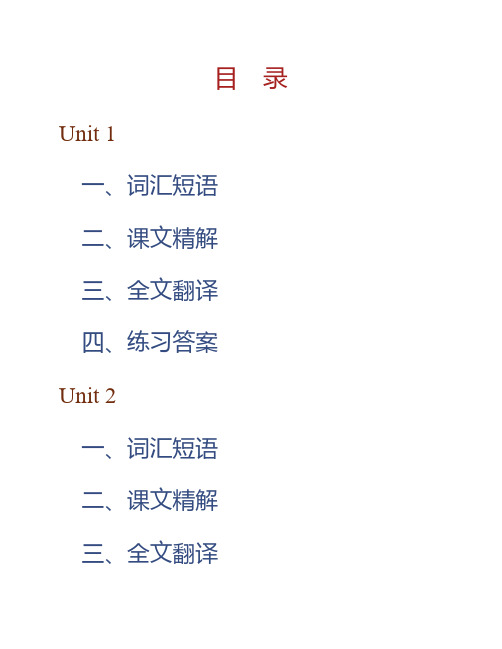
mad on 对…入迷,狂热地喜欢(某人);渴望,为…生气 go mad 发疯;失去理智 【派生】maddening adj. 令人发狂的;使人恼火的 madly adv. 疯狂地;发狂地;精神失常地 madness n. 疯狂;愚蠢的行为 inconsistency [9InkEn`sIstEnsI] n. 前后不一致;矛盾 【例句】She noticed several minor inconsistencies in his argument. 她觉察 到他的论点有几处略微有些自相矛盾。 【词组】time inconsistency 时间不一致性,时间矛盾 attempt [E5tempt] n. 努力,尝试,企图 vt. 尝试,企图 【例句】I attempted to read the entire novel in one sitting. 我试图一次读完 整本小说。 【词组】attempt on sb’s life企图杀害某人 attempt at企图 attempt at doing sth企图做某事;尝试做某事 【助记】at(一再)+ tempt(尝试)→一再尝试→企图 nationalistic [7nAFEnE5listik] adj. 国家主义的 【例句】This is a movement which was romantic, irrational and vehemently nationalistic in character. 这是一场具有荒诞的,反理性的,鼓吹民族主义性质的运动。
【词组】under sb.’s thumb 在某人的支配下;任人驱使 thumb down 贬低;拒绝,责备 thumbs up/down 表示成功或赞许[失败或拒绝] 的用语或手势) 【助记】由于该词和词义为“总数”的单词sum读音相近,则可记成:挑 起大拇指(thumb),意味着总数(sum)。 to this day至今
英语专业课程学习指南周玉忠主编
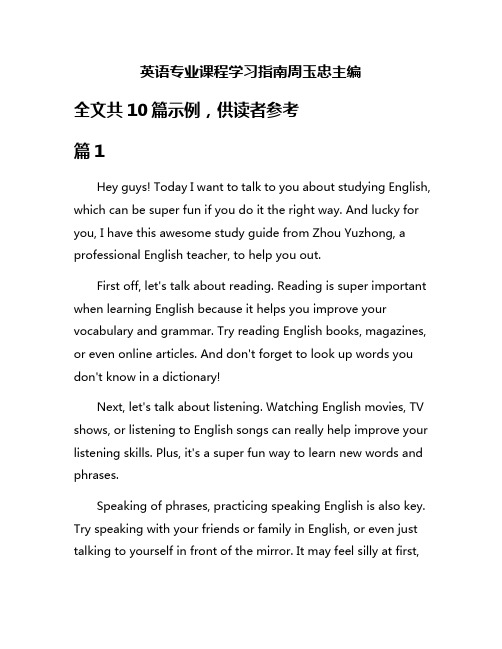
英语专业课程学习指南周玉忠主编全文共10篇示例,供读者参考篇1Hey guys! Today I want to talk to you about studying English, which can be super fun if you do it the right way. And lucky for you, I have this awesome study guide from Zhou Yuzhong, a professional English teacher, to help you out.First off, let's talk about reading. Reading is super important when learning English because it helps you improve your vocabulary and grammar. Try reading English books, magazines, or even online articles. And don't forget to look up words you don't know in a dictionary!Next, let's talk about listening. Watching English movies, TV shows, or listening to English songs can really help improve your listening skills. Plus, it's a super fun way to learn new words and phrases.Speaking of phrases, practicing speaking English is also key. Try speaking with your friends or family in English, or even just talking to yourself in front of the mirror. It may feel silly at first,but it really helps you become more confident in your speaking skills.And lastly, writing. Writing in English can be a great way to practice your grammar and spelling. Try keeping a journal in English, or writing emails to pen pals in other countries.So there you have it, guys! Follow this study guide, and you'll be speaking English like a pro in no time. Good luck, and happy studying!篇2Hey everyone! Today I'm going to tell you all about the English major courses we can study with the help of the guidebook edited by Zhou Yuzhong.First of all, let's talk about the basics. English major courses are super important if we want to become experts in English. The guidebook helps us understand the different courses we can take, like English Literature, Linguistics, Translation, and much more.In English Literature, we get to read lots of cool books and learn about famous authors like Shakespeare and Jane Austen.It's like going on a magical adventure through the pages of a book!In Linguistics, we learn all about how languages work and why English sounds the way it does. It's like solving a mystery of how words and sentences come together to communicate.In Translation, we get to practice turning words from one language into another. It's like being a language detective, trying to find the perfect match for every word.The guidebook also helps us choose our electives, like Creative Writing or Business English. These courses can help us explore different aspects of English and find what we're really passionate about.So remember, studying English major courses is not only fun but also super important for our future careers. The guidebook is like our treasure map, guiding us through the world of English studies. Let's make the most of it and become English experts together!That's all for now, see you in the English major classes!Bye-bye!篇3Hello everyone! Today I want to share with you a study guide for English major courses, which is edited by Zhou Yuzhong. English major courses can be a bit tricky, but don't worry, I'm here to help you navigate through them!First, let's talk about the importance of English major courses. As an English major, you will need to master various skills such as reading, writing, speaking, and listening. These skills are crucial in today's globalized world, where English is widely used in business, education, and communication.Next, let's discuss how to study effectively for English major courses. Here are a few tips:1. Make a study schedule: Plan out your study time for each course and stick to it. This will help you stay organized and on track.2. Practice regularly: Practice your English skills daily by reading books, writing essays, practicing speaking with a language partner, and listening to English podcasts or songs.3. Seek help when needed: Don't be afraid to ask your professors or classmates for help if you're struggling with a certain concept or assignment. They are there to support you.4. Review regularly: Review your notes and assignments regularly to reinforce your learning and ensure you understand the material thoroughly.In addition, the study guide edited by Zhou Yuzhong can be a great resource for your English major courses. It provides valuable insights, tips, and exercises to help you succeed in your studies.Remember, with dedication and hard work, you can excel in your English major courses. Good luck, and happy studying!篇4Hey guys!Today I want to share with you some tips on how to study English like a pro. English is a super important subject, and I know it can be a little tricky sometimes. But don't worry, I've got your back! Here are some tips that will help you ace your English classes:1. Read, read, read! Reading is super important when it comes to learning English. Try to read as much as you can, whether it's books, magazines, or online articles. This will help you improve your vocabulary and comprehension skills.2. Practice your speaking skills. Don't be shy to speak English out loud, even if you make mistakes. The more you practice, the better you will become. You can even practice with your friends or family members!3. Write, write, write! Writing is another important skill to practice. Try keeping a journal in English, or writing short stories or essays. This will help you improve your grammar and writing skills.4. Use technology to your advantage. There are so many apps and websites that can help you learn English, such as Duolingo, Quizlet, and Grammarly. Take advantage of these resources to make your learning process easier.5. Watch English movies and TV shows. This is a fun way to improve your listening skills and pick up on new vocabulary. Plus, it's a great way to relax and enjoy yourself!Remember, practice makes perfect. The more you practice your English skills, the better you will become. So keep working hard and don't give up! You've got this.Good luck with your English studies!Yours truly,[Your Name]篇5Hi everyone, I'm super excited to share with you my tips for studying English! My name is Emily and I love learning new things, especially languages. Today, I want to introduce you to a super cool book called "English Major course Learning Guide" edited by Zhou Yuzhong.First of all, it's important to stay organized when studying English. Make a study schedule and stick to it. Set aside time each day to practice reading, writing, listening, and speaking. Remember, consistency is key!Next, don't be afraid to ask for help. If you don't understand something, ask your teacher or a classmate for clarification. It's okay to make mistakes, as long as you learn from them.Another great tip is to immerse yourself in the English language. Watch English movies, listen to English music, and read English books. The more exposure you have to the language, the faster you'll improve.Practice, practice, practice! The more you practice, the more confident you'll become in using English. Try writing essays, having conversations with friends, or even talking to yourself in English.Lastly, don't forget to have fun! Learning a new language can be challenging, but it can also be a lot of fun. Celebrate your progress, reward yourself for reaching goals, and don't give up.I hope these tips help you on your English learning journey. Remember, with hard work and dedication, you can achieve anything! Good luck!篇6Hello everyone, I'm so excited to share with you all about the English major courses that we will be studying together. This study guide, written by our awesome teacher Mr. Zhou Yuzhong, will help us understand what to expect and how to do our best in our English classes.First of all, English is super important because it helps us communicate with people from all around the world. So, let's make sure we pay attention in class and practice speaking, reading, and writing in English as much as we can.In our English classes, we will learn about grammar, vocabulary, reading, writing, and even some cool stuff about English literature. It might sound a bit challenging, but don't worry, Mr. Zhou will be there to help us every step of the way.To do well in our English classes, we need to make sure we listen carefully in class, ask questions when we don't understand, do our homework on time, and practice English outside of the classroom. We can read English books, watch English movies, listen to English songs, and even chat with our friends in English.Remember, practice makes perfect, so let's work hard together and have fun learning English! Mr. Zhou and our classmates will be here to support each other and make learning English an amazing experience.So, let's get ready to dive into the world of English language and literature! Let's study hard, have fun, and become English experts together. Let's do this! Go, English team!That's all for now, see you all in class! Bye-bye!篇7Title: A Fun Guide to Studying English ProfessionsHi everyone, today I'm going to tell you all about studying English professions! My teacher, Mr. Zhou Yuzhong, compiled a super cool book that can help us learn all about this subject. So let's dive in and see what we can find out!First of all, why should we study English professions? Well, English is a super important language all around the world. When we study English professions, we can learn about different jobs like translators, English teachers, writers, and so much more. It can open up lots of opportunities for us in the future!In Mr. Zhou's book, there are so many fun activities to help us learn. We can practice our English writing by creating our own stories or articles. We can also do role plays to act out different professions in English. And don't forget about vocabulary games and quizzes to test our knowledge!One really cool thing in the book is the interviews with real professionals in English-related jobs. We can learn about their experiences, tips, and how they got to where they are today. It's so inspiring to hear about all the possibilities in the world of English professions.So, if you want to have fun while learning about English professions, make sure to check out Mr. Zhou's book. It's full of exciting activities, interesting information, and practical tips. Let's all work hard and become superstars in the world of English professions!That's all for now, guys! Thanks for listening and keep on shining bright in your English studies. Bye-bye!篇8Hello everyone! Today I'm going to share with you a guide for studying English courses, edited by Zhou Yuzhong. English is a super cool subject, but sometimes it can be a bit tricky. Don't worry, I'm here to help you navigate through it all!First things first, make sure you pay attention in class. Listen to your teacher and take good notes. This will help you remember important information for your exams and assignments. Also, don't be afraid to ask questions if you don't understand something. Teachers are there to help you!Next, it's important to practice your English skills outside of class. Try reading English books or watching English movies to improve your vocabulary and comprehension. You can also practice speaking with your friends or family members who speak English. The more you practice, the better you'll become!Another tip is to set goals for yourself. Whether it's getting a certain grade on a test or improving your speaking skills, having goals will keep you motivated and focused. You can even reward yourself when you reach your goals, like treating yourself to a snack or watching your favorite TV show.Lastly, don't be afraid to make mistakes. Learning a new language can be tough, but everyone makes mistakes along the way. Just keep practicing and learning from your errors. Remember, the more you practice, the better you'll become!So there you have it, a guide for studying English courses. Just remember to pay attention in class, practice outside of class, set goals for yourself, and don't be afraid to make mistakes. With these tips, you'll be acing your English courses in no time! Good luck and happy studying!篇9Hey guys, do you want to learn more about English? I've got this super cool guide for you! It's called "Study Guide for English Major Courses" and it's been put together by Zhou Yuzhong.First off, let's talk about why it's important to learn English. English is a really important language because it's used all over the world. If you want to travel, work or study abroad, knowing English is super helpful. Plus, it's also the language of the internet and a lot of movies and TV shows are in English.In this guide, you'll find all the tips and tricks you need to ace your English major courses. There are chapters on grammar,vocabulary, reading, writing, speaking and listening. Each chapter has lots of examples and exercises to help you practice.One tip I found really helpful is to read as much as you can in English. It could be books, articles, or even social media posts. The more you read, the better your English will get.Another tip is to practice speaking with your friends or classmates. You can have conversations in English, watch English movies together or even join an English club. The more you practice speaking, the more confident you'll become.So if you want to improve your English skills and have fun while doing it, make sure to check out this study guide. It's got everything you need to succeed in your English major courses. Happy learning!篇10Hello everyone, I am so excited to share with you the study guide for our English major courses! My name is Timmy and I will be your guide as we navigate through the wonderful world of English language and literature.First of all, let me introduce you to our textbook - "English Major Courses Study Guide" by Zhou Yuzhong. This book coverseverything you need to know about English grammar, vocabulary, reading, writing, and more. It is a must-have for all English majors!When studying grammar, make sure to pay attention to the different tenses, sentence structures, and parts of speech. Practice writing sentences using each grammar rule to solidify your understanding. Don't forget to review regularly to ensure you remember everything.Expand your vocabulary by reading as much as you can in English. Make a habit of looking up new words in a dictionary and using them in your conversations and writings. The more you read, the more words you will learn and understand.In our reading courses, be sure to analyze the text carefully and identify the main themes, characters, and literary devices used by the author. Take notes while reading to help you remember important points and prepare for class discussions.Writing is a crucial skill for English majors, so practice writing essays, reports, and creative pieces regularly. Pay attention to your grammar, punctuation, and organization of ideas. Don't be afraid to ask for feedback from your teachers or peers to improve your writing skills.Lastly, make sure to participate actively in class discussions, group activities, and presentations. This will not only help you improve your speaking and listening skills but also deepen your understanding of the subject matter.I hope this study guide helps you excel in your English major courses. Remember to stay motivated, study hard, and never stop learning. Good luck!。
亚历山大 新概念英语 1 学习指南 文档
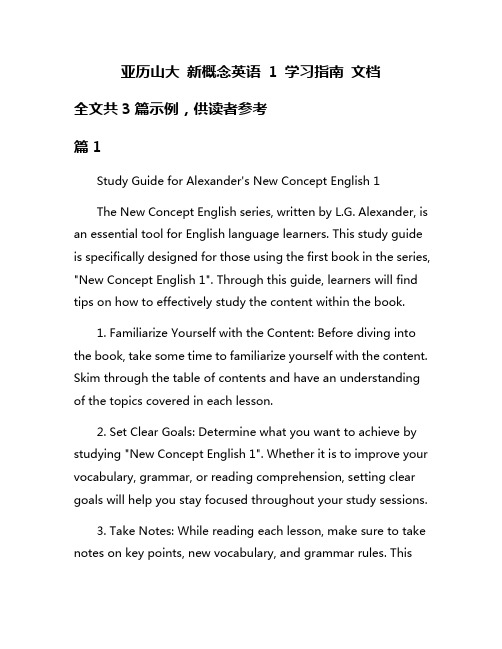
亚历山大新概念英语1 学习指南文档全文共3篇示例,供读者参考篇1Study Guide for Alexander's New Concept English 1The New Concept English series, written by L.G. Alexander, is an essential tool for English language learners. This study guide is specifically designed for those using the first book in the series, "New Concept English 1". Through this guide, learners will find tips on how to effectively study the content within the book.1. Familiarize Yourself with the Content: Before diving into the book, take some time to familiarize yourself with the content. Skim through the table of contents and have an understanding of the topics covered in each lesson.2. Set Clear Goals: Determine what you want to achieve by studying "New Concept English 1". Whether it is to improve your vocabulary, grammar, or reading comprehension, setting clear goals will help you stay focused throughout your study sessions.3. Take Notes: While reading each lesson, make sure to take notes on key points, new vocabulary, and grammar rules. Thiswill help reinforce your learning and make it easier to review later.4. Practice, Practice, Practice: The key to mastering English is practice. Utilize the exercises provided in the book to test your understanding of the material. Additionally, seek out additional practice materials online or through English language apps.5. Seek Help When Needed: Don't be afraid to ask for help if you are struggling with a particular concept. You can reach out to a teacher, tutor, or join online forums to get clarification on any questions you may have.6. Be Consistent: Consistency is key when learning a new language. Make a study schedule and stick to it to ensure steady progress.7. Review Regularly: Periodically review the material you have covered in "New Concept English 1" to reinforce your learning and ensure that you retain the information.8. Apply What You've Learned: Practice using the new vocabulary and grammar rules you have learned in real-life situations. Whether it is through conversations with native speakers, writing essays, or watching English language movies,applying what you've learned will help solidify your understanding.By following this study guide, learners can effectively use "New Concept English 1" as a tool to improve their English language skills. Remember that learning a language takes time and dedication, so be patient with yourself as you progress through the book. Good luck with your studies!篇2Title: Study Guide for "New Concept English 1" by AlexanderIntroduction"New Concept English 1" by Alexander is a widely used textbook for English learners. This study guide aims to provide learners with useful tips and strategies to make the most out of their study of the book.Section 1: Study Schedule- Create a study schedule to allocate time for reading, exercises, and revision.- Break down the book into manageable sections to cover every day.- Set specific goals for each study session to track your progress.Section 2: Active Reading- Engage actively with the text by underlining key words, phrases, and sentences.- Take notes on important points, grammatical structures, and vocabulary.- Summarize each lesson in your own words to ensure comprehension.Section 3: Vocabulary Building- Create flashcards for new words and review them regularly.- Use the words in sentences to understand their meaning and usage.- Practice using the words in conversations or writing exercises.Section 4: Grammar Practice- Complete the exercises at the end of each lesson to reinforce your understanding of grammar rules.- Identify and correct your mistakes to improve your accuracy.- Review previous lessons to ensure retention of grammar concepts.Section 5: Listening Skills- Listen to the audio recordings for each lesson to practice your listening skills.- Transcribe the sentences or passages to improve your listening accuracy.- Engage in listening activities such as watching English movies or podcasts.Section 6: Speaking Skills- Practice speaking by reading aloud the dialogues and passages from the book.- Record yourself speaking and listen to identify areas for improvement.- Engage in conversation with native speakers or language partners to practice speaking in real-life situations.Section 7: Writing Skills- Practice writing short essays or paragraphs on topics covered in the book.- Use the grammar and vocabulary learned in the book to enhance your writing.- Seek feedback from teachers or peers to improve your writing skills.ConclusionBy following this study guide for "New Concept English 1" by Alexander, learners can enhance their English proficiency and achieve their language learning goals. Remember to stay consistent, motivated, and dedicated to your studies to see progress over time. Happy learning!篇3A Study Guide for New Concept English 1 by ALEXANDERNew Concept English is a comprehensive English language learning course written by the well-known English linguist and educator A. J. Alexander. It is aimed at students who are new to learning English as a second language, and it covers a wide range of topics and skills necessary for effective language acquisition.This study guide is designed to help students make the most of their study of New Concept English 1, the first book in the series. Here are some tips and strategies to help you succeed in your English language learning journey:1. Develop a routine: Consistency is key when it comes to language learning. Make a schedule that fits into your daily routine and stick to it. Set aside a specific time each day to study New Concept English 1, whether it's in the morning before work or in the evening before bed.2. Review regularly: Language learning is all about repetition and practice. Make sure to review the material you've learned in New Concept English 1 on a regular basis to reinforce your understanding and retention of the content.3. Practice speaking: Language learning is not just about reading and writing, it's also about speaking. Practice speaking English with a study partner, a tutor, or even by recording yourself and listening back to identify areas for improvement.4. Expand your vocabulary: One of the key components of language learning is vocabulary acquisition. Make a list of new words and phrases you've learned from New Concept English 1 and make an effort to use them in conversation and writing.5. Seek additional resources: New Concept English 1 is a great starting point, but don't hesitate to explore other resources such as online language learning platforms, language exchange partners, and English language podcasts to supplement your learning.By following these tips and strategies, you can make the most of your study of New Concept English 1 and greatly improve your English language skills. Remember, language learning is a journey, so be patient, persistent, and most importantly, have fun! Good luck!。
人教英语八上Unit1学习指南
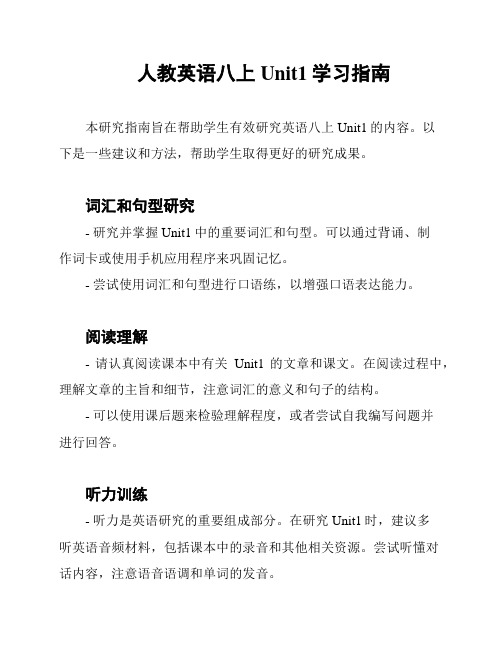
人教英语八上Unit1学习指南
本研究指南旨在帮助学生有效研究英语八上Unit1的内容。
以
下是一些建议和方法,帮助学生取得更好的研究成果。
词汇和句型研究
- 研究并掌握Unit1中的重要词汇和句型。
可以通过背诵、制
作词卡或使用手机应用程序来巩固记忆。
- 尝试使用词汇和句型进行口语练,以增强口语表达能力。
阅读理解
- 请认真阅读课本中有关Unit1的文章和课文。
在阅读过程中,理解文章的主旨和细节,注意词汇的意义和句子的结构。
- 可以使用课后题来检验理解程度,或者尝试自我编写问题并
进行回答。
听力训练
- 听力是英语研究的重要组成部分。
在研究Unit1时,建议多
听英语音频材料,包括课本中的录音和其他相关资源。
尝试听懂对
话内容,注意语音语调和单词的发音。
- 练听力可以选择使用录音材料进行模仿。
通过反复听、模仿和跟读,提高听力和口语能力。
口语交流
- 鼓励与同学进行英语口语交流。
可以进行角色扮演、讨论话题或进行小组活动,以增强口语表达和沟通能力。
写作训练
- 研究并运用本单元的写作技巧。
可以通过练写作短文、书写日记或写信等方式,提高写作能力。
- 注意语法和拼写错误,并善用语法手册和字典进行查阅和纠正。
以上是针对人教英语八上Unit1的学习指南。
希望以上建议能够帮助学生更好地掌握课程内容,取得优秀的学习成绩。
祝学习愉快!。
Project Management study guide计划管理学习指南(英文版)
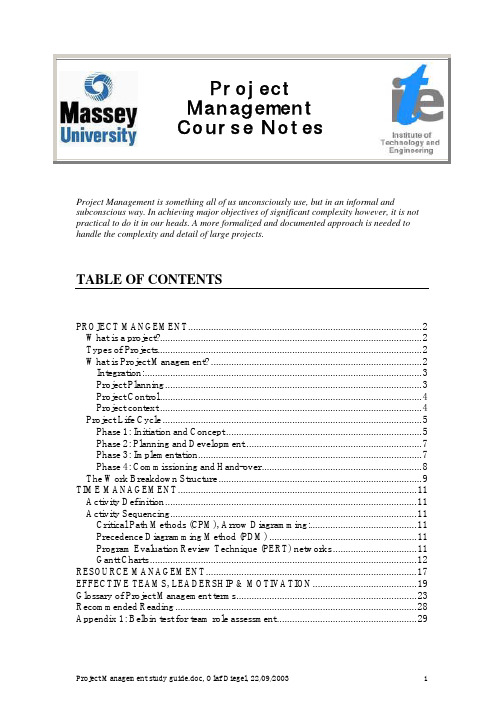
ProjectManagementCourse NotesProject Management is something all of us unconsciously use, but in an informal and subconscious way. In achieving major objectives of significant complexity however, it is not practical to do it in our heads. A more formalized and documented approach is needed to handle the complexity and detail of large projects.TABLE OF CONTENTSPROJECT MANGEMENT (2)What is a project? (2)Types of Projects (2)What is Project Management? (2)Integration: (3)Project Planning (3)Project Control (4)Project context (4)Project Life Cycle (5)Phase 1: Initiation and Concept (5)Phase 2: Planning and Development (7)Phase 3: Implementation (7)Phase 4: Commissioning and Hand-over (8)The Work Breakdown Structure (9)TIME MANAGEMENT (11)Activity Definition (11)Activity Sequencing (11)Critical Path Methods (CPM), Arrow Diagramming: (11)Precedence Diagramming Method (PDM) (11)Program Evaluation Review Technique (PERT) networks (11)Gantt Charts (12)RESOURCE MANAGEMENT (17)EFFECTIVE TEAMS, LEADERSHIP & MOTIVATION (19)Glossary of Project Management terms (23)Recommended Reading (28)Appendix 1: Belbin test for team role assessment (29)PROJECT MANGEMENTWhat is a project?A project is a temporary endeavour undertaken to create a unique product or service. Temporary means that every project has a definite ending point. Unique means that the product or service is different in some distinguishing way from all similar products or services (PMBOK 1997)A project is an activity with:• Finite duration (A specific starting and end point) • It has a well-defined goal • It is unique• It is not repetitive• It is constrained by time, cost and quality• It often cuts across organisational and functional lines • Always involves changeTypes of ProjectsAlmost all projects can be considered to fir into at least one of four generic types of projects:Type 1: Both goals and methods are well defined at the outset (e.g.: Engineering projects) Type 2: Goals are initially well defined, but methods of achieving them are not (e.g.: ProductDevelopment)Type 3: Goals are not initially well defined, but methods are known (e.g.: some softwaredevelopment projects)Type 4: Neither the goals nor the methods are well defined (e.g.: many R&D projects,organisational change projects)TYPE 2Product DevelopmentTYPE 4R&D and Organisationalchange TYPE 1EngineeringTYPE 3Applications software developmentYesNoY e sN o M e t h o d s w e l l d e f i n e dGoals well definedTurner & Cochrane’s Goals-and-Methods MatrixWhat is Project Management?Project Management is integration of project activity through the project life-cycle to achieve the delivery of a defined product or service within the prescribed constraints of time, budget, scope and quality.Project Management is normally viewed as having 9 primary components, with Integration having a further 3 elements:•Integration Managemento Project Planning and controlo Project contexto Project life cycle•Scope Management•Time Management•Cost Management•Quality Management•Human Resource Management•Communication Management•Risk Management•Procurement ManagementIntegration:Project PlanningProject planning involves the planning of all the project management functions, and their integration into a cohesive whole.Typically, planning starts with defining the project scope, in which the desired quality of the final product is embedded. A Product Breakdown Structure (PBS) is then developed, followed by a Work Breakdown Structure (WBS), which establishes the basic work packages for executing the project. The Work packages are then further broken down into activities, which form the basis for time, resource and cost planning.Time planning involves establishing the sequencing and relationships of all activities (typically be developing a project network), estimating how long each activity will take (which depends on resources available and allocated), and thence developing a project schedule. This then forms the basis for controlling project time.Cost plans/ estimates are primarily calculated from pricing the resources allocated to the scheduled project activities for their estimated durations. These form the basis for detailed cost controlTypically there is tension between scope, quality, time and cost objectives. This can best be represented as a triangle. The marker in the centre shows that each objective is equally important. However, at different points of the project the relative importance that each objective has may change, which can be indicated by moving the marker within the triangle to indicate the current priority in achieving the objectives.COSTResource plans are part of the time and cost plans, and include human resource plans, which are often represented by an Organisational Breakdown Structure (OBS) and responsibility matrices/ charts. These in turn form part of communications planning. Risk assessment and procurement planning are normally undertaken early in the project.Project ControlPlanning and control are completely intertwined. Planning without subsequent control processes wastes much of the planning. Control without prior planning is a contradiction in terms.The ‘Deming wheel’ represents the planning and control cycle in an easily understandable diagram using few words.Project contextProject context includes both internal and external environmentsInternal environments may include:•Physical location of the project•Layout of project personnel and equipment•Personal working conditions (physical and emotional)•Team and interpersonal dynamics•Identity and differentiation of the project within the larger environmentExternal environment may include:•The parent organisation, enterprise, industry•Employee representative groups (unions, associations, etc)•Political, social and societal influences•Public and media interest•The physical environment (geography, ecology, sensitivity)•External stakeholder expectationsProject Life CycleFollowing is a commonly used generic 4-phase model used to describe a project:Phase 1: Initiation and ConceptPhase 1 is concerned with determining/ confirming the business (or equivalent) needs of the client and key stakeholders, and thence the requirements of the project “product” which will satisfy those needs.This is followed by the task of identifying the project objectives, examining alternative ways of achieving those objectives, developing an optimum project solution (via feasibility studies), and obtaining approval and commitment to “run with” that solution. The resultant Project Definition Report documents and consolidates the work to date, and extends it to developing preliminary strategies and plans for implementing the recommended solution. The phase involves:•Setting the project up right from the start•Doing the groundwork to ensure that it is the right project, in the right place, and the right time, and for the right client/customer/stakeholders.•Defining and agreeing what is really required•Deciding if it really is required.Concept and Initiation Planning andDevelopment ImplementationCommissioningandHandoverNeeds Analysis Project Appraisal Project Definition Identify needs and opportunities Identify StakeholdersIdentify needs of Stakeholders Establish project objectives Generate alternative approaches Appraise alternative approaches Document optimumThe outcomes of this phase should include• A GO / NO GO decision for the project• A Project Definition Report, or Terms of ReferenceThe Project Definition ReportA project Definition Report communicates the outcomes of the Initiation and Concept phase to the project sponsors.A project definition report should typically include the following key elements:•Authority and project sponsor (delegation)•Purpose (need)•Project scope / Deliverables•Project objectivesIt should describe:•The client needs•Options explored and reasons for rejection of options not analysed•Marketing and costing data•Scope, cost and time plans•Evaluation criteria•Cash flows•Financial performance indicators•Sensitivity of project outcomes to risk•Recommendations on viability of the project and conditions under which the viability will be retained•Risk management strategies that may need to be adoptedThe project purpose or need should be clearly and precisely stated and should contain both quantitative and qualitative measures. It should eb a statement of the business need to be achieved by the project. It may be:• A problem to be solved•An opportunity to be exploited•Elimination of an efficiency•Derived from strategic objectives of the organisationThe project scope should be an initial high level description of the way in which the purpose will be satisfied. Statements of scope should include:•What work is included in the project•What work is outside the gambit of the projectThe project objectives are what the ultimate success of a project are usually judged by. It is therefore important to get these right from the start. These will act as the guidelines for decision making throughout the project and for the achievement of the end result.It should also be remembered that different clients/ customers/ stakeholders/ participants/ constituencies will identify different objectives in a project.The project objectives should:•Be aligned with business objectives•Be measurable in terms of quality, quantity, time, cost and defined end product•Be achievable•Be consistent•Be readily understandable•Have the full support and commitment of senior management, project sponsor and users.Phase 2: Planning and DevelopmentPhase 2 is concerned with developing and refining (i.e.: progressively elaborating) the project solution developed in Phase 1 to the point that implementation of the agreed concept can be undertaken in an orderly and controlled way.Generally the project team will be expanded to include the expertise necessary to fully plan and develop the project. The Project Manager will also start putting in place the major systems and controls necessary to manage the project to completion.Concept and Initiation Planning andDevelopment ImplementationCommissioningandHandoverExplain objectives and setup teamPrepare programs and budgetsPrepare schematics and the design planAssess value for money and exposure to riskPrepare documentationBrief the “doer”Typically, tenders are called for supply or procurement at the end of this stage.Outputs of this phase should include:•Detailed plans•Detailed designs•Detailed costings•Detailed programs and networks.Phase 3: ImplementationPhase 3 is basically a delivery process. It is concerned with ensuring that the approved scope of the project (design, specification, etc. elaborated in Phase 2) is converted into the agreed product (scope), and that the other key objectives for the project in terms of time and quality are achieved within the agreed cost limits.It is the commencement of a stage where the client cannot make major changes, as significant resources are now committed to executing the project. It is also a stage during which highly formalised contractual relationships are established to protect the parties. Often the major tasks will be undertaken by contractors and/or consultants outside the organisation, in which case the setting up and management of contracts for procurement and production will be a major role for the project team.Concept and Initiation Planning andDevelopment ImplementationCommissioningandHandoverReview documentationand setup teamPlan work packages andallocate to teamsEstablish progress andchange control systemsExecute work packagesImplement controls andtake corrective actionsAccept completed work &hand over to next phaseThe outputs of this stage could include a new product launched on the market, and operational building, a new computer or accounting system, or a multitude of other products of the project.Phase 4: Commissioning and Hand-overThis phase is fundamental to the success of a project. The objective of Phase 4 is to integrate the project’s outcome into the client organisations normal and on-going operations. This may include:•Testing of systems, facilities or products•Procedures, manuals, and guidelines•Resourcing and training the on-going operation.Concept and Initiation Planning andDevelopment ImplementationCommissioningandHandoverTransfer & commissionthe productObtain the benefitDisband the teamUndertake post-completion reviewsThe phase concludes with a thorough review and evaluation of both the product, and the management systems that were used to produce it.The Work Breakdown StructureThe Military Standard (MIL-HDBK-881) defines the Work Breakdown Structure as follows: "A work breakdown structure is a product-oriented family tree composed of hardware, software, services, data and facilities .... [it] displays and defines the product(s) to be developed and/or produced and relates the elements of work to be accomplished to each other and to the end product(s)."What it all meansA $10,000,000 project can usually be regarded as a lot of smaller $10,000 projects joined together. The larger a project is, the more difficult it can be to comprehend all it's complexities. Projects are therefore organized and broken down into progressively smaller pieces, thus making them easier to comprehend. The Work Breakdown Structure is used to provide a framework to tie all these project elements together. The clustering of end products, project elements and project tasks helps to divide the overall project work into manageable pieces. The resulting structure can then serve as the basis for communication, scheduling, cost management, estimating resource requirements, etcThe WBS is used to graphically break up a project into manageable elements reflecting all products to be delivered and services to be performed by the project. It relates the elements of work to be accomplished to each other and to the end product. It is a product-oriented family tree composed of hardware, software, services, data, and facilities.Though some project management environments have rather rigid conventions for grouping items in a WBS (witness the MIL-HDBK-881, which very precisely defines items that can be included in the WBS and excludes certain others), a more effective method is to have a WBS that is tailored to the particular project environment it is being used in. The WBS design should specifically try to achieve certain goals.•It should be compatible with how the work will be done and how costs and schedules will be managed.•It should help to identify and give visibility to important or risky work elements.•It should ultimately act as a map of all requirements, plans, testing, and deliverables.•As it is primarily a communication tool, it should foster clear ownership by managers and task leaders.•It should provide data for performance measurement and historical databases that can be used on future projects.•And possibly most importantly, it must make sense to the workers, accountants and all others involved in the project.A sample of a standard WBS is shown in the figure below:A WBS for a large project may have multiple levels of detail, and the lowest WBS element will be linked to functional area cost accounts that are made up of individual work packages. Irrespective of how many levels the WBS has, work packages should add up through each WBS level to form the total project deliverable.Many project management software packages (such as MS-Project) often display the WBS as a vertical list with indents to show structure, thus making them compatible with the Gantt chart type data views.WBS ElementA WBS element is an individual, discrete portion of the WBS representing an identifiable component item such as an engine, or software routine, a set of data such as training documentation, or a service such as integration and assembly. WBS elements are organized into a hierarchy of levels beginning with Level One items. Level Two WBS elements are major components that make up their corresponding Level 1 items. Level Three items are elements subordinate to the respective Level Two elements, and so on... The WBS should include as many levels as necessary to fully define the work at hand.Numbering and WBS IndexWBS elements are usually numbered, and the numbering system should be arranged in the way that makes the most sense to the project team. One of the more conventional numbering systems is used in the above figure (and is the standard required for the US military use of WBSs). The shaded box shown in the above figure could be numbered 1.2.2.3, which would tell you it was in the second box in level 2, the second box in level 3, and the third box in level 4.TIME MANAGEMENTTime management or planning is traditionally the function most strongly identified with Project Management. Time management involves establishing the sequencing and relationships of all activities (typically by developing a project network), estimating how long each activity will take (which depends on resources available and allocated), and thence developing a project schedule.Activity DefinitionBefore one can sequence activities, they first need to be defined. An activity is any identifiable task that must be performed within the project. These activity definitions most commonly come from the Work Breakdown Structure.Activity SequencingAt its very simplest, this is simply a list of activities, and the order in which it is planned they will be executed. More commonly however, this can be done in the form of network scheduling. There are many methods for developing networks, but 4 of them are prevalent: Critical P ath Methods (CPM), Arrow Diagramming:Arrow diagrams (also known as activity-on-arrow networks) were first publicised in 1959, and became the de facto standard for several years. The benefits of using Precedence Diagramming Method (PDM) however slowly but surely came to be recognised, and this method overtook Arrow Diagramming as the new de facto standard.Precedence Diagramming Method (PDM)Precedence Diagramming (also known as activity-on-node networks) is now the de facto standard for CPM networking.Program Evaluation Review Technique (PERT) networksPERT is an acronym that stands for P rogram E valuation R eview T echnique. It was originally developed in the late 1950s - early 1960s as a management tool for the U.S. Navy's Polaris submarine project; Booz Allen (the consulting firm), Lockheed Aircraft, and the Navy are generally credited with developing the concept. PERT charts have been used widely in industry and government projects since then; many people now refer to them as activity diagrams.In a PERT chart, each rectangular box represents a task or an activity (i.e., a recognizable chunk of work that needs to be done). The boxes with rounded corners are known as milestones, and they have an obvious meaning within the context of a typical project. The lines connecting the boxes show dependencies; that is, they show which activities must be finished prior to the commencement of some other activity. The heaviest, dark lines that form a contiguous path from the beginning to the end of the project represent the critical path, those activities whose delay would force a delay in the overall project (activities not on the critical path have “slack time” available; they can be started later than the scheduled date up to the amount of slack time available, if desirable, without affecting the overall project).Gantt ChartsA Gantt chart represents the activity information as a bar graph, but has the added advantage that the length of each bar represents the duration of each task (so analogous to marking out the tasks on a calendar). It therefore has the advantage of graphically showing the duration of the project. Most modern project management computer programs such as Microsoft Project have become extremely easy to use, and can show Gantt charts with or without the critical path, and they can also be displayed as ‘tacking’ Gantt charts in which our current progress is indicated on the chart.The easiest way of understanding the various techniques is through an example:“Holiday Time”You and 3 of your friends (Tom, Dick and Harry) have decided to go on holiday . The holiday will officially start on the Monday after the end of first semester exams. After preparing and packing you will drive to the holiday place. The problem is to select a location and take all the necessary steps to successfully get to the holiday place in a minimum of time after the holiday officially starts.If you were to generate a Work breakdown Structure for this project, it might look somethinglike this:Obtain travel brochuresObtain road mapsDecide money limits Select holiday placeBook holiday place Service carArrange house-sitterPack clothing and gearPrepare travel snacksDrive to holiday siteHOLIDAY!!!The first step is to generate a list of Activities (things to be achieved) from the WBS and decide on the sequence of execution. This is achieved through a Precedence List that may be in the form of a table or a simple list. It might typically appear as shown below:Number Activity Precedence 1 Obtain travel brochures Must precede 42 Obtain road maps Must precede 43 Decide money limits Must precede4 4 Select holiday place Must precede 5,8,95 Book holiday place Must precede 106 Service car Must precede 87 Arrange house-sitter Must precede 108 Pack clothing and gear Must precede 109 Prepare travel snacks Must precede 10 10Drive to holiday siteAt this point, we can also define the time needed to execute each activity. We will leave the start/finish times undefined at the moment although these could be filled in. The target start date is however the Monday after exams.Number Activity Earliest start Time Latest Finish Time Time Required (days) 1Obtain travel brochures1.0 2 Obtain road maps 1.0 3 Decide money limits0.1 4 Select holiday place 1.0 5Book holiday place1.0 6 Service car 1.0 7 Arrange house-sitter0.5 8 Pack clothing and gear 1.0 9 Prepare travel snacks 0.5 10Drive to holiday site1.0Note that the above lists, though extremely useful, are difficult to instantly comprehend. This is because the brain does not handle large quantities of information well. On the other hand, the brain does deal very well with images. This is the main reason that network diagrams are worth developing and so commonly used. They present a graphical view of the project that we can very easily comprehend.If we wanted to graphically show all this information, we could construct and Activity-on-Arrow network diagram:Diagram 1. Critical Path Method, Activity on Arrow Network Diagram (hours in brackets)In this type of diagram, each activity is represented by an arrow. The circles at the beginning and end of each arrow are called ‘events’ or ‘nodes’. These are just points in time that have no duration. Each arrow, however, does have duration, which is most commonly written in brackets beneath the activity. Work always flows in the direction of the arrows.Notice the dotted arrow between ‘c’ and ‘d’. This is called a dummy arrow. Dummy arrows are used to transfer logic from one event node to another in the network. They are represented by broken arrows. A dummy arrow has zero duration and does not represent an activity. These symbols are used to represent the relation ships among the activities.Or, the diagram can be redrawn as an Activity-on Node Diagram as shown belowDiagram 2. Precedence Diagramming Method, Activity on Node Network DiagramNotice that there is no need for the dummy arrow in this diagram.Network diagrams 1 and 2, make it quite easy to see the "dates" after each activity. This is particularly easy with Diagram 1. Taking "a" as day 0, therefore, b is +1, c is +2, d is +2, e is +3 and f is +4. Notice that the LONGEST time between each node is taken as the required time between nodes. It is now a simple matter to fill in the earliest start dates and the latest finish dates for each activity of Table 1. This is shown below:Table 3. Complete Timing Details of ActivitiesNumber Activity Earliest StartTimeLatest FinishTimeTime Required(Days)1 Obtain travel brochures Mon Tue 1.02 Obtain road maps Mon Tue 1.03 Decide money limits Mon Tue 0.14 Select holiday place Tue Wed 1.05 Book holiday place Wed Thurs 1.06 Service car Mon Wed 1.07 Arrange house sitter Mon Thurs 0.58 Pack clothing and gear Wed Thurs 1.09 Prepare travel snacks Wed Thurs 0.510 Drive to holiday site Thurs Fri 1.0Another method of showing this network is using the Program Evaluation Review Technique (PERT).All of the above types of networks can be considered to be only a semi graphical way of depicting the activities (tasks) as they give no graphical indication of time. Times are indicated in brackets beneath the activities, or in the lower parts of the boxes for PERT, but they need to be manually calculated to arrive at a total.This is an area where the Gantt chart comes in handy.The various arrows in the above chart indicate that certain tasks cannot begin until the preceding ones are finished.Note that certain other tasks have blank space to the right or left of them. If a bar in the Gantt chart is shorter than the actual time needed for the task, then the activity is said to possess Slack or Float. This means that those activities can be started a bit earlier or later without affecting the final date of the project.The critical path, on the other hand, has no slack in any of its activities. It is possible for there to be several critical paths.It is common practice to start tasks with float as early as possible, as this then leaves float for later in the project to handle unforeseen occurrences.It should be noted that each diagramming method has certain advantages, depending on what you are trying to show. Many projects may develop more than one type of network diagram to make everything as simple as possible to understand. This is an other area that makes most software packages useful, as most of them can automatically generate different network views.If you are using Microsoft Project, for example, then the Gant chart can also be displayed with its Critical path (detailed Gantt), or as a PERT diagram, etc.The Gantt chart is an excellent communication tool, not only for management, but also for those involved in the project. It is something that may go up on the wall or be used in a presentation to give a quick and easily understood chart of project sequence.RESOURCE MANAGEMENTA problem so far not mentioned, is that of resources.In the above holiday example, it is assumed that Tom, Dick, and Harry are helping out and doing their fair share of the organising. But what happens if you are doing all the organising on your own?In the holiday planning, it takes a day to obtain the maps, and another day to obtain the brochures. In project planning, time is almost always given as man/hours, or man/days, etc. This means that the one day given for obtaining the brochures represents one persons full-time working day (usually assumed to be 8 hours per day, for example).In all the above networks, we are however running these two tasks in parallel, which means that at least 2 people are needed to do these two tasks.If only Harry has a valid drivers license, and will therefore be the one doing all the driving, would it be fair for Tom, Dick and Yourself to do some extra work on the planning tasks?In the above example, we have randomly allocated tasks to everyone as follows:As can easily be seen with our current set-up (indicated by the exclamation mark sign), Tom has been over-allocated, as he is working 16 hours on the Monday and his tasks are to obtain the roadmaps, and get the car serviced.This can be fixed in one of 2 ways. Either we need to assign someone else who is not working on the Monday (Harry, for example) to service the car, or we need to delay the car servicing (remember that this task has some float, so is not on the critical path) until Tuesday when Tom is not scheduled to work.Note also that Dick is working less than everyone else, so it may be fairer to redistribute the labour somewhat. We could for example take one of Harry’s tasks and assign it to Dick. That way, everyone would be working around 16 hours for the holiday.The above example is perhaps over-simplified. It should be remembered that in real projects, resources are often affected by factors such as areas of expertise, etc. If for example there is only one registered electrician available, then he must do all the electrical tasks, and may therefore be a scarce resource.。
新编简明英语语言学教程第2版学习指南答案
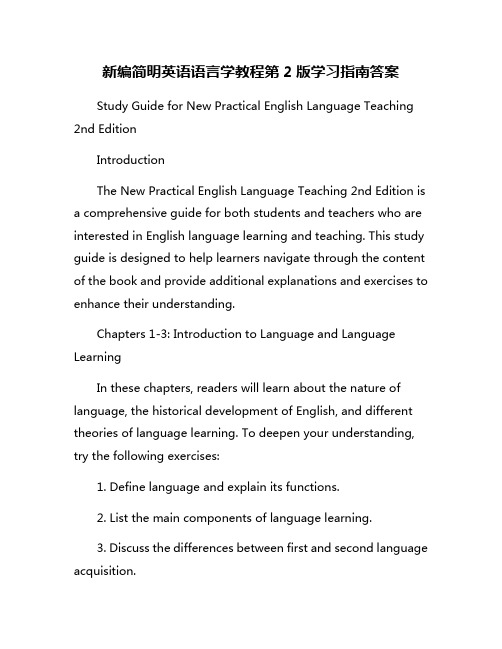
新编简明英语语言学教程第2版学习指南答案Study Guide for New Practical English Language Teaching 2nd EditionIntroductionThe New Practical English Language Teaching 2nd Edition is a comprehensive guide for both students and teachers who are interested in English language learning and teaching. This study guide is designed to help learners navigate through the content of the book and provide additional explanations and exercises to enhance their understanding.Chapters 1-3: Introduction to Language and Language LearningIn these chapters, readers will learn about the nature of language, the historical development of English, and different theories of language learning. To deepen your understanding, try the following exercises:1. Define language and explain its functions.2. List the main components of language learning.3. Discuss the differences between first and second language acquisition.Chapters 4-6: The Sound System of EnglishThese chapters cover phonetics and phonology, including the International Phonetic Alphabet (IPA) and pronunciation rules. To practice your phonetic skills, try these exercises:1. Transcribe the following words into IPA: cat, dog, house.2. Identify the stress patterns in the following words: banana, computer, dictionary.3. Pronounce the following consonant and vowel sounds: /θ/, /æ/, /ʃ/, /uː/.Chapters 7-9: The Structure of EnglishThese chapters focus on grammar and syntax, including word classes, sentence structure, and verb tenses. To test your grammatical knowledge, try the following exercises:1. Identify the parts of speech in the following sentences: The cat chased the mouse. She is a talented singer.2. Construct sentences using different verb tenses: past simple, present continuous, future perfect.3. Analyze the sentence structure of the following sentences:I can't believe you did that!Chapters 10-12: Vocabulary and SemanticsThese chapters explore vocabulary development, word formation, and meaning in language. To expand your vocabulary, try these exercises:1. Create a semantic map for the word "happy" and its synonyms.2. Identify the affixes in the following words: uncomfortable, misunderstanding, redevelopment.3. Use context clues to determine the meaning of the following words: ambiguous, exhilarating, juxtaposition.Chapters 13-15: Language Teaching MethodologiesThese chapters introduce different approaches to language teaching, including the Communicative Approach, Task-Based Learning, and Content-Based Instruction. To evaluate your teaching strategies, try these exercises:1. Compare and contrast the Communicative Approach with Grammar-Translation Method.2. Design a task-based lesson plan for teaching vocabulary to beginners.3. Integrate content knowledge into a language lesson for intermediate learners.ConclusionThe New Practical English Language Teaching 2nd Edition is a valuable resource for students and teachers alike. By using this study guide and completing the exercises, you will enhance your language skills and teaching abilities. Remember to practice regularly and seek feedback from others to improve your proficiency in English. Happy learning!。
初学者的英语学习指南
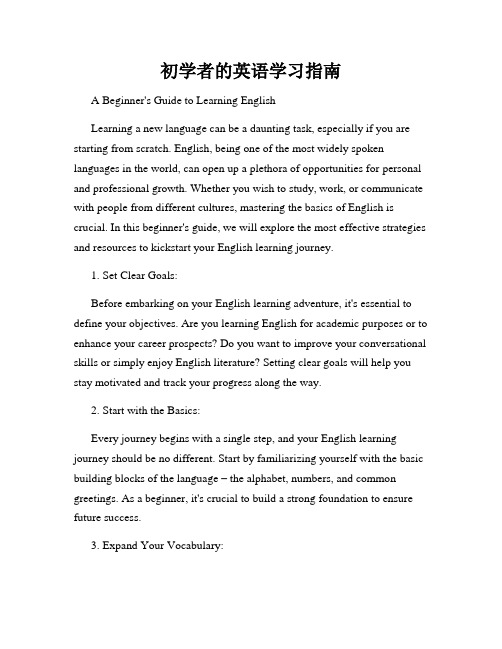
初学者的英语学习指南A Beginner's Guide to Learning EnglishLearning a new language can be a daunting task, especially if you are starting from scratch. English, being one of the most widely spoken languages in the world, can open up a plethora of opportunities for personal and professional growth. Whether you wish to study, work, or communicate with people from different cultures, mastering the basics of English is crucial. In this beginner's guide, we will explore the most effective strategies and resources to kickstart your English learning journey.1. Set Clear Goals:Before embarking on your English learning adventure, it's essential to define your objectives. Are you learning English for academic purposes or to enhance your career prospects? Do you want to improve your conversational skills or simply enjoy English literature? Setting clear goals will help you stay motivated and track your progress along the way.2. Start with the Basics:Every journey begins with a single step, and your English learning journey should be no different. Start by familiarizing yourself with the basic building blocks of the language – the alphabet, numbers, and common greetings. As a beginner, it's crucial to build a strong foundation to ensure future success.3. Expand Your Vocabulary:Building a solid vocabulary is key to becoming fluent in any language. Begin by learning commonly used words and phrases that are relevant to your goals. Flashcards, vocabulary apps, and online word lists can be valuable tools to enhance your language skills. Additionally, immersing yourself in English-speaking environments through movies, music, and reading will help expand your vocabulary naturally.4. Develop Listening and Speaking Skills:Speaking and listening skills are the backbone of effective communication. Practice listening to spoken English through podcasts, radio shows, or even language learning apps. Try to mimic the pronunciation and rhythm of native speakers to improve your own speaking skills. Engaging in conversation with native speakers or joining language exchange programs can also provide invaluable speaking practice opportunities.5. Master Grammar and Sentence Structure:Grammar can be intimidating, but it is fundamental to English proficiency. Start with the basics such as verb tenses, sentence structure, and common grammatical patterns. Understanding grammar rules will help you construct coherent sentences and avoid common errors. Online grammar exercises, language textbooks, or even hiring a tutor can assist you in mastering this aspect of the language.6. Read Extensively:Reading is an excellent way to expose yourself to new vocabulary, sentence structures, and cultural nuances. Start with easy-to-understand materials such as graded readers or simplified versions of popular books. Asyour skills progress, challenge yourself with more complex texts. Make a habit of reading regularly to enhance your comprehension skills and broaden your knowledge.7. Write Regularly:Writing is an essential skill that allows you to express yourself accurately. Start by practicing simple sentence construction and gradually progress to more complex writing tasks. Journaling, email exchanges, or even starting a blog in English can help refine your writing skills. Utilize online grammar checkers or seek feedback from native speakers to improve your writing accuracy and style.8. Embrace Language Learning Technology:In today's digital world, there are numerous language learning platforms and apps available to aid your English journey. Duolingo, Babbel, and Rosetta Stone are just a few examples of popular language learning apps. These platforms offer interactive exercises, vocabulary drills, and even speaking practice through voice recognition technology. Take advantage of these resources to supplement your learning and make the process more enjoyable.9. Immerse Yourself in English:To truly excel in English, immerse yourself in the language as much as possible. Surround yourself with English media, watch movies and TV shows, listen to English podcasts and music, and engage with native speakers. Consider participating in language exchange programs or even planning a trip to an English-speaking country. By immersing yourself, youwill accelerate your learning and gain a deeper understanding of the language and culture.10. Stay Consistent and Motivated:Learning a language requires dedication and perseverance. Set aside regular study time and establish a routine that works for you. Celebrate small victories and milestones along the way to maintain motivation. Keep in mind that progress may not always be linear, but with dedication and consistency, you will gradually become more proficient in English.In conclusion, learning English as a beginner may seem challenging, but with the right strategies and resources, it becomes an achievable goal. Set clear goals, start with the basics, and gradually build your skills in listening, speaking, reading, and writing. Embrace technology, immerse yourself in the language, and most importantly, stay consistent and motivated. Remember, the key to success lies in perseverance and a willingness to step out of your comfort zone. So, grab your English learning guide and embark on this exciting language learning journey today.。
- 1、下载文档前请自行甄别文档内容的完整性,平台不提供额外的编辑、内容补充、找答案等附加服务。
- 2、"仅部分预览"的文档,不可在线预览部分如存在完整性等问题,可反馈申请退款(可完整预览的文档不适用该条件!)。
- 3、如文档侵犯您的权益,请联系客服反馈,我们会尽快为您处理(人工客服工作时间:9:00-18:30)。
第二册第一单元精读学习指南Unit One LovePeriods 1-2:1. Oral preparation:1.Now, try to use one sentence to describe your understanding of love.e.g.Love is when a girl puts on perfume and a boy puts on shaving cologne and they go out and smell each other.2. Think about a person you love most and explain why.Try to use the words listed in P1.2. A word game:To give some words initiated by those letters, with relative meaning to “father”:e.g. F: F may stand for “friends”….A:T:H:E:R:3. 预习并掌握p. 4-7新单词, 特别掌握以下单词的用法adjust: 句型:adjust to sb./sth. 调整,适应cling: 句型:cling to sb/sth 抓紧,抱紧…complain: 句型: complain about/of + n. ; complain that+句子。
Complain的派生词:n.______________coordinate: vt. 协调步伐____________________vi. 医生和护士协调一致抵御SARS病毒。
___________________________________co作为前缀,表示together的意思,那么与co连用的复合词还有哪些:___________________________________despite: prep. 尽管(= in spite of )e.g. __________ nasty weather, he went to work.envious: 句型:be envious of sb./sth. 对……嫉妒frustration: n. 它的v. adj. 分别是:________ ________reluctance: e.g. She accept the invitation ______(填介词) reluctance.see to it that…确保;务必要(注意:后面跟的从句中一般不用进行时态和将来时态)e.g. 确保明天早上准时到达。
翻译:_______________________________________.subject ···to ···使……承受;使遭受e.g. The patients in that ward____________________ infection.那间病房里的病人受了感染。
Periods 3-4:1.预习课文并完成课后page 8-10 第一大题,第三, 第四大题。
2.思考以下问题:How do you understand the title “A Good Heart to Lean on”?What is “good heart” in your understanding?3.根据下面的提示内容找出课文叙述的关键词,准备课堂讨论。
Periods 5-6:1.配音。
(稍后我会发视频,第四周口语课展示)2.Words focused on in the passage (词语辨析):(1)lean on(title): v. depend on someone or something for support and encouragement 依靠eg: Don’t always lean on others for help. Simply leaning on inviting several senior foreign coaches cannot fundamentally change the current situations of Chinese football.(2)ice-free (Line 18, Para. 4) adj. 不会冰冻的;不冻的-free表示“无······的、免除······的”之义sugar-free beverage ________________duty-free shop ____________________(3) content与satisfactorycontent 表示对某一特殊事物满意或指在一定程度上对现实感到满意。
作形容词时,只能用作表语。
satisfactory 侧重性质、状态方面的描写。
e.g.They will not be _________with the victory already got.The way the patients are responding to the new treatment is most _____________.(5) envy与jealousyenvy 主要指“羡慕”别人的好运,希望自己也有好运;jealousy 语义比envy强,指对别人占有的或自己企图占有的东西感到不满或者怀有恼恨心理,认为应属于自己或自己应得。
He was filled with _________ at his friend’s success.She was blinded by __________ to her fellow workers’ achievement.2. Sentence focused on in the passage.(1) More than I realized, Dad has helped me keep my balance. (Subtitle)more than I realized: beyond my realization 在句中为插入成分,具有否定的含义,可理解为:我没有意识到,正是父亲帮助我保持心理平衡。
eg: After hard construction work, the beauty of the city is more than words can describe.翻译:_________________________________________________________________________The young man entertained his roommates with stories, some of which could really more thanbe believed.翻译:_________________________________________________________________________(2) He was severely crippled and very short, and when we would walk together, his hand on my arm for balance, people would stare. (Line 1) (请参考独立主格微课)名词+现在分词/名词+过去分词/名词+介词短语, 其功能往往相当于一个状语从句。
请用独立主格结构改写下面的句子:Because all the airplanes had been cancelled, we had to go there by train._______________________________________________________________________He was lying on the sands leisurely and putting his arms under his head._______________________________________________________________________(3)He never talked about himself as an object of pity, nor did he show any envy of the more fortunate or able. (Line 26)类似的否定词组有:at no time; by no means; under no circumstance; in no way; in vain; on no consideration; no sooner…than; not only…but also; not until; etc.用nor 改写下列句子:The article is too long, and the style is not easy._______________________________________________________________________He had understood nothing, and he didn’t try to understand._______________________________________________________________________3.完成课后练习p. 10-11 (Vocabulary and Translation)Period7预习After-class Reading:A Kiss for Kate。
